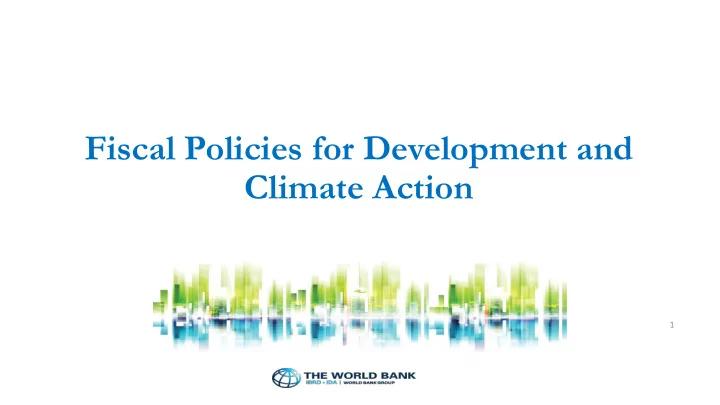

Fiscal Policies for Development and Climate Action 1
The growing importance of climate-smart fiscal policies in the developing world ➢ The effects of climate change are already evident. Rising average temperatures are slowing global growth and inhibiting progress on poverty reduction and on the Sustainable Development Goals. ➢ Greenhouse gas (GHG) emissions in developing countries now exceed those in developed countries. ➢ Less-developed countries are especially vulnerable to the effects of climate change, as are poor households worldwide. ➢ Fiscal instruments can reduce carbon emissions in a cost- efficient manner while advancing development goals. 2
Meeting the challenge: mitigation, adaptation, risk management Fiscal risks management: Mitigation: measures to slow Adaptation: measures to policies that strengthen fiscal the pace and lessen the reduce the damage caused by preparedness, build response severity of climate change. climate change. capacity, and promote resilience. 3
Environmental Tax Reform: Benefits beyond Climate
What is environmental tax reform (ETR)? ETR combines taxes on: • pollutants – CO2 (carbon tax), NOx, SO2, solid waste • energy – coal, electricity, petroleum, diesel • transportation – road, shipping & air duties, congestion with measures to allocate the revenues: ➢ To lower other, more distortive taxes (e.g., labor taxes) ➢ Expenditure policies: ➢ Investments in infrastructure, human development, or climate-change adaptation; ➢ Rebates – e.g. to less polluting emitters; ➢ Compensation – e.g. to bottom quintiles and supplementary policies: • Fossil fuel subsidy reforms • Changes to R&D policies 5
ETR has direct and indirect effects on well-being 6
Leveraging Fiscal Policy to Support Climate-Change Adaptation 7
Climate change adaptation can be described as essentially “development in a hostile climate.” - Nicholas Stern 8
Climate change is a gradual process punctuated by extreme events Gradual process : Extreme events : Some aspects of climate Climate change also change, such as crop increases the frequency displacement and rising and severity of weather- sea levels, have a related shocks, such as relatively slow but hurricanes, tornados, progressively and droughts, which can intensifying economic inflict severe human and impact. economic costs in a short period of time. 9
Adapting to climate change requires complementary actions that build resilience to both its gradual and extreme effects Infrastructure investment: Disaster management: risk Financing instruments: Public policies: pricing dikes, seawalls, irrigation and analyses, early warning microcredit, insurance, and drainage networks, and other systems, communication reforms, zoning measures, other financial products building codes, and other systems that reduce the strategies, and other designed to manage risk and damage from environmental measures to mitigate the regulations that integrate promote the efficient climate resilience changes and extreme weather economic and human costs of reallocation of resources events natural disasters 10
Fiscal policy can play a key role in climate- change adaptation and disaster response Early, preventive investments Credible fiscal rules to avoid a Fiscal buffers, such as in adaptation combined with procyclical fiscal response to contingency funds, built up policies to maintain adequate the economic volatility gradually and disbursed fiscal space and ease generated by climate change according to clearly defined borrowing constraints and extreme weather events criteria Financial resilience: (i) ex A climate dimension added to Climate-change ante financing arrangements; the chart of accounts to allow considerations mainstreamed (ii) self-insurance, and policymakers to systematically into the design, appraisal, and contingent instruments; and plan, track, and manage selection of public investment (iii) disaster-risk insurance climate-related spending projects (e.g., parametric insurance, catastrophe bonds ) 11
A Fiscal-Policy Package for Climate Resilience and Development 12
Using fiscal policy to combat climate change while accelerating development (1) 1. Adopt policies for climate mitigation: • Start with a public outreach campaign to build political support for environmental tax reforms. • Reduce/eliminate fossil fuel subsidies. Compensatory policies to support poor household and affected firms should be put in place. Implementation should be gradual. • Introduce carbon taxes or build carbon costs into existing fuel taxes, then use the revenues to reduce distortive taxes, to increase investment in adaptation/social spending and to offset the distributional and poverty effects of higher fuel taxes. • If carbon pricing is politically unfeasible, use other instruments (command and control policies, regulations etc.) 13
Using fiscal policy to combat climate change while accelerating economic growth (2) 3. Strengthen resilience by investing in adaptation, building fiscal buffers, and creating or enhancing insurance mechanisms. • Maintain fiscal space and ease borrowing constraints. • Invest in selected public goods (e.g. early warning systems) and build fiscal buffers • Include climate-related fiscal risks in fiscal risk statements and budget processes • Integrate climate considerations into all stages of the public-investment cycle • Develop a comprehensive financing strategy for climate-change mitigation and adaptation • Incorporate disaster-risk management into fiscal rules, medium-term fiscal frameworks, and debt sustainability analyses • Explore innovative ways to transfer risks to markets, as well as mechanisms to pool risks at the national, regional, or international level 14
Thank You 15
Recommend
More recommend